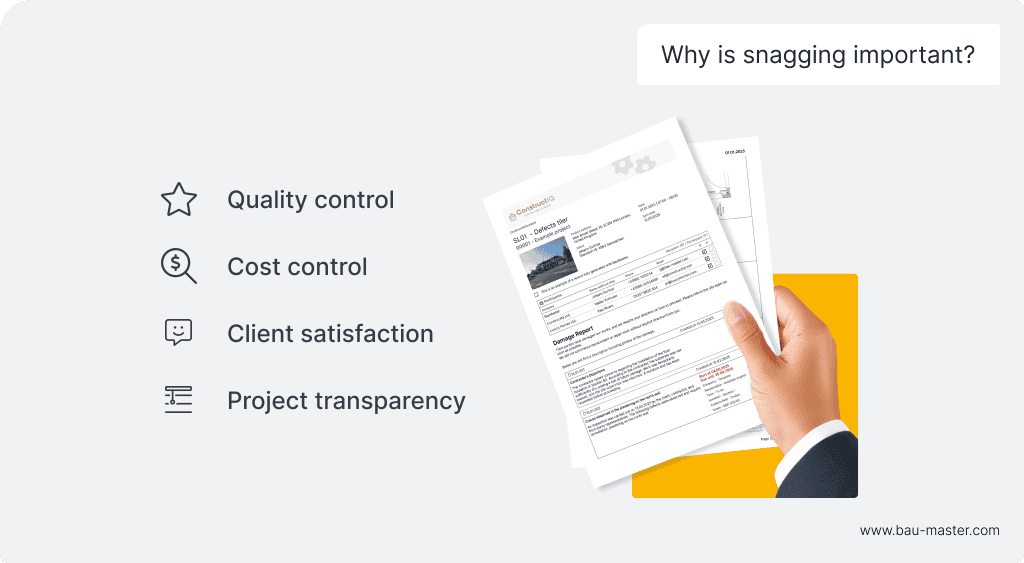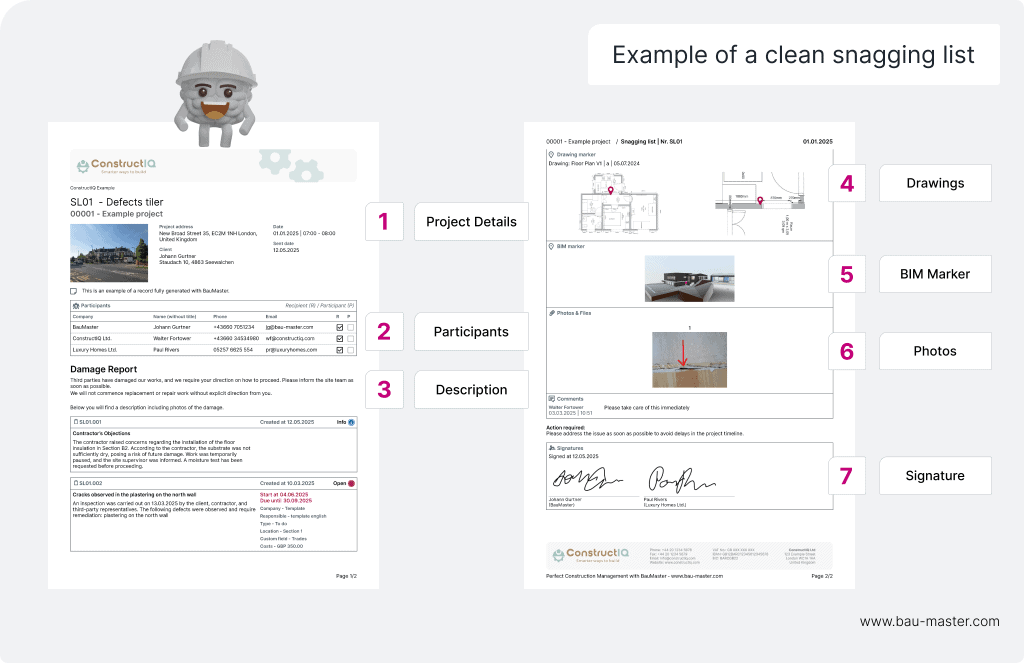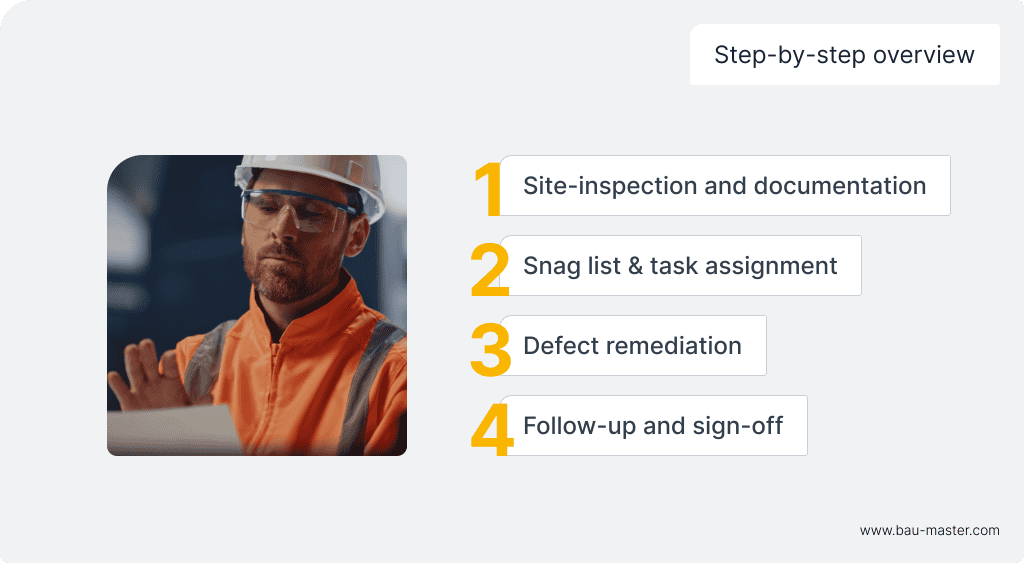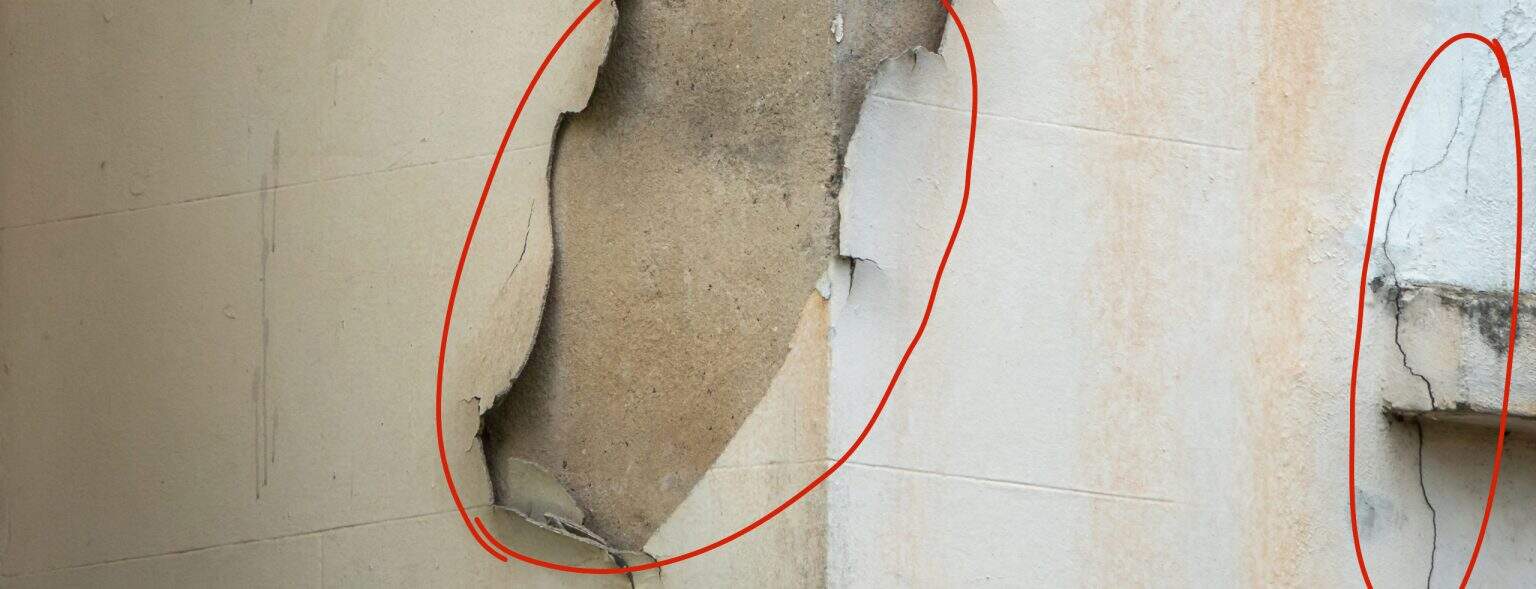As a construction project nears completion, ensuring that everything has been built and installed to specification becomes critical. This is where the snag list comes in: a practical, structured way to identify and communicate issues that still need attention.
Whether you’re working on a new build or a refurbishment, a well-managed snag list can make all the difference. Find out more in this guide!
- What is a snag list (or snagging list)?
- Why is snagging important?
- Typical defects in snagging lists
- What should be on a snagging list?
- The snagging process: step-by-step overview
- The challenges of snagging with Word, Excel and similar tools
- Digital solutions – the smart way to handle snags
- The meaning of snag lists for the success of construction projects
- FAQ – Frequently asked questions on snagging lists
Snagging lists at a glance
What is a snagging list? A snagging list is a tool used to document and resolve minor construction defects before project handover.
Why does snagging matter? It plays a critical role in ensuring quality, especially in new build projects where client expectations are high.
How to manage the snagging process?
1. Inspect the site and document issues.
2. Create the snag list and assign tasks.
3. Track the remediation process.
4. Re-inspect and sign off.
Why use a specialised tool for snagging? Paper-based methods and isolated tools (like Word or Excel) are inefficient and prone to errors – a snagging tool makes the process faster and more transparent.
Create structured snag lists with BauMaster:
Get to know our construction log software
What is a snag list (or snagging list)?
A snag list – also known as a snagging list, deficiency list or punch list (in the US) – is a checklist of pending issues that need to be addressed before a construction project can be considered complete. It typically includes minor defects, incomplete tasks, or details that deviate from the original plans and specifications.
Unlike formal defect notifications or legal claims, a snag list is primarily practical in nature. It’s about clear communication and accountability – not about legal disputes. This makes it particularly useful as a hands-on quality management tool at the final stage of a build.

Why is snagging important?
Snagging is important for a number of reasons:
Snag lists in new builds
Snag lists are especially crucial in new build projects, for construction businesses and homebuyers alike. Identifying and resolving small issues early ensures that clients receive a home that meets their expectations – and avoids the stress, cost, and friction of post-handover complaints.
Buyers and residents increasingly expect a defect-free handover. A structured snag list helps construction teams deliver exactly that – and strengthens trust between all parties involved.
Typical defects in snagging lists
Snag lists typically cover a wide range of minor issues that must be addressed before handover. These can be grouped into several common categories:
What should be on a snagging list?
A snag list should provide all necessary details to ensure quick and accurate resolution. At a minimum, it should contain:
Make sure your snagging list is clear, unambiguous, and detailed. A well-structured and thorough protocol helps ensure every issue is documented correctly and gives you a solid legal foundation in the event of future disputes.
Below, you will find an example of what a structured report can look like:

The snagging process: step-by-step overview
While snagging can vary in detail depending on the project type and scale, the process typically follows a set of clear steps:
- Site inspection and documentation
- Snag list and task assignment
- Defect remediation
- Follow-up and sign-off
1. Site-inspection and documentation
Before you can write a snag list, you must first document the issue. Record the extent of the defect, the exact location and other important information. Be sure to collect detailed evidence, e.g. in the form of construction photo documentation.
2. Snag list & task assignment
The next step is to create a snagging list with all the above-mentioned components and send it to the contractor without delay. Reporting defects immediately is essential – that way, they can be rectified promptly and not accidentally get lost in the shuffle of day-to-day construction.
The fastest way to do this is through digital defect management with tools like BauMaster. Record faults and assign tasks to responsible trades directly on-site, during the inspection.
3. Defect remediation
Once the snag list is sent, remediation can begin. Important: The deadline for rectifying the defect must be reasonable. Allow for the time it may take to inspect the defect, order additional materials, and perform the work to correct the defect.
4. Follow-up and sign-off
After remediation, a re-inspection is carried out to verify that all identified issues on the snag list have been properly resolved. Once all items are confirmed as completed, the snag list is formally closed, allowing the project handover to proceed.

The challenges of snagging with Word, Excel and similar tools
Despite the rise of digital tools, paper-based snagging is still common on construction sites, often relying on handwritten notes. Excel sheets or Word templates may seem like a simple, straightforward alternative, but they come with several challenges:
Digital solutions – the smart way to handle snags
To overcome those limitations, digital construction management offers a more structured and efficient approach. Tools like the BauMaster app make it easy to document, track, and resolve defects directly on-site using a smartphone or tablet.
Key benefits of switching to digital defect management include:
In short: Whether working with external partners or managing internal quality control, BauMaster makes the snagging process fast, professional, and transparent.
The meaning of snag lists for the success of construction projects
The true meaning of a snag list goes beyond simply compiling a checklist of minor defects. When managed properly, snagging can be the deciding factor between a smooth project closeout and a handover plagued by delays and disputes.
Transitioning from isolated tools to holistic digital solutions allows construction teams to handle snagging more efficiently, minimise errors, and maintain transparency across all stages of the project.
To keep the process on track, follow these best practices:
FAQ – Frequently asked questions on snagging lists
When should you write a snagging list?
Snagging usually occurs when the building is essentially finished and ready for handover, but final checks still need to be made. Most construction teams use a rolling snag list, identifying and resolving issues continuously throughout the project. A construction daily log software can be a tremendous help in this process.
Who is involved in the snagging process?
Snagging is a collaborative task involving the site manager, contractor, subcontractors, and often the client or their representative. Each party plays a role in identifying, documenting, and closing out snags.
What evidence should a snag list contain?
A snag list should contain at least a precise description of the defect and photographic documentation. In addition, a sketch or plan marker can help clarify the location and extent of the defect.
What happens if I do not report snags before the handover?
If snags are not reported before the handover, you may lose the right to have them rectified under the original contract terms. This can lead to a costly remediation process or even legal disputes.









